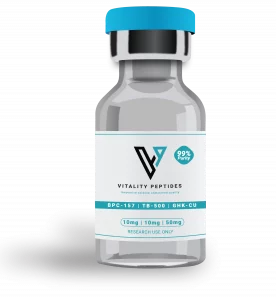GHK-Cu Peptide: Benefits for Skin and Tissue Research

Exploring GHK-Cu: Copper Peptide Applications in Skin and Tissue Studies
What if a single peptide could accelerate healing, boost collagen, and help reverse visible signs of aging? Enter GHK-Cu, the copper peptide at the center of some of the most promising skin and tissue regeneration studies to date. From dermal repair to anti-inflammatory effects, GHK-Cu is gaining serious traction in the research world.
In this post, we’ll explore how GHK-Cu works, why it’s exciting researchers across the globe, and what its future applications might hold.
What is GHK-Cu?
GHK-Cu, short for glycyl-L-histidyl-L-lysine:copper(II), is a naturally occurring copper-binding peptide found in human plasma, saliva, and urine. Discovered in the 1970s, it has been widely studied for its ability to:
Stimulate collagen and elastin synthesis
Promote wound healing
Modulate inflammation
Enhance skin remodeling
Its structure allows it to transport copper ions into cells, making it a powerful candidate for skin regeneration and anti-aging applications in both cosmetic and clinical settings.
Key Functions of GHK-Cu in Skin and Tissue Studies
1. Collagen Stimulation and Skin Remodeling
One of the primary focuses in GHK-Cu research is its impact on collagen production. In multiple studies, GHK-Cu has demonstrated the ability to:
Increase the expression of collagen types I and III
Promote the production of glycosaminoglycans (essential for skin hydration)
Support fibroblast proliferation, crucial for dermal health
This makes GHK-Cu a strong candidate in studies aimed at reversing photoaging, fine lines, and skin thinning.
2. Anti-Inflammatory and Antioxidant Effects
GHK-Cu has also shown promise as a modulator of inflammation. It appears to:
Reduce levels of reactive oxygen species (ROS)
Downregulate pro-inflammatory cytokines like TNF-α and IL-6
Increase antioxidant enzyme activity (e.g., superoxide dismutase)
These effects make it useful in tissue repair models involving oxidative stress or chronic inflammation.
3. Wound Healing and Tissue Regeneration
In preclinical studies, GHK-Cu has been linked to accelerated wound closure. It appears to:
• Enhance angiogenesis (new blood vessel formation)
•Improve keratinocyte and fibroblast migration
•Reduce scar formation through better ECM remodeling
Researchers investigating diabetic wounds, burn recovery, and post-surgical tissue repair have shown significant interest in GHK-Cu’s therapeutic potential.
Scientific Evidence Supporting GHK-Cu Applications
Several peer-reviewed studies have demonstrated GHK-Cu’s bioactivity:
A 2012 study published in Biomed Research International found GHK-Cu improved skin elasticity and thickness in aged subjects.
In Journal of Biomaterials Science, GHK-Cu accelerated epidermal regeneration in dermal fibroblast cultures.
A 2018 review in Molecular and Cellular Biochemistry highlighted its role in gene expression modulation, affecting over 4,000 human genes involved in repair and growth.
These findings provide a robust foundation for continued investigation into GHK-Cu’s therapeutic applications.
Why Researchers Are Excited About GHK-Cu
GHK-Cu’s unique profile gives it a competitive edge in peptide research:
Biocompatibility: Naturally present in the body, it poses a low risk of immunogenicity.
Stability in Formulations: It remains active when lyophilized and stored properly.
Broad Activity Range: GHK-Cu can be used in studies ranging from anti-aging dermatology to tissue regeneration therapies.
Its multifunctional nature allows researchers to explore it across multiple domains, including cosmetic science, regenerative medicine, and even oncology (where it’s being investigated for anti-cancer properties).
GHK-Cu in Cosmetic vs Clinical Research
While cosmetic brands have rushed to incorporate GHK-Cu into topical formulas, clinical researchers are exploring its deeper mechanisms. Here’s how it’s being applied in different settings:
Cosmetic Use:
Anti-wrinkle serums
Eye creams and firming treatments
Scalp and hair care products
Clinical/Research Use:
Scar treatment and wound therapy
Post-surgical recovery
Skin graft acceptance
Pressure ulcer repair
The “research use only” status of pure GHK-Cu allows scientists to investigate its full range of biological effects before it enters mainstream therapeutic protocols.
How to Store and Handle GHK-Cu for Research
To maintain its bioactivity, GHK-Cu should be stored in lyophilized powder form at -20°C. Upon reconstitution with bacteriostatic water, it should be refrigerated (2–8°C) and used within a few weeks, depending on the concentration and application.
Always follow proper research handling protocols and ensure the peptide is labeled for non-human, non-medical use to remain compliant with regulations.
Future Directions in GHK-Cu Research
GHK-Cu is only just beginning to reveal its potential. Current and upcoming areas of interest include:
Combination therapies with other growth factors
Nanoparticle delivery systems for targeted action
Gene regulation studies focusing on epigenetic pathways
Application in bioengineered skin scaffolds
As researchers continue to unlock its mechanisms, GHK-Cu may become a staple in advanced tissue regeneration protocols.
Final Thoughts
GHK-Cu stands out as one of the most promising bioactive peptides in the realm of skin and tissue research. With its broad regenerative capabilities, strong safety profile, and versatility, it continues to be a focal point for cutting-edge peptide science.
Ready to Explore GHK-Cu?
-
 £79.40Select options This product has multiple variants. The options may be chosen on the product page
£79.40Select options This product has multiple variants. The options may be chosen on the product page -
 £24.90 – £42.90Price range: £24.90 through £42.90Select options This product has multiple variants. The options may be chosen on the product page
£24.90 – £42.90Price range: £24.90 through £42.90Select options This product has multiple variants. The options may be chosen on the product page

